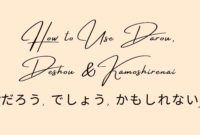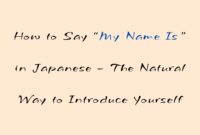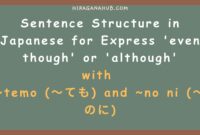Changing Verbs to Past Tense (ta-kei)
Konnichiwa, everyone! How’s it going? I hope you’ve mastered the negative verb
forms we studied earlier. If you haven’t, review them first because learning
the basics is key for more advanced lessons.
Now, let’s move forward! Today, we’ll learn how to change Japanese verbs into
the past tense, known as the “ta-kei” form. This form is used to express
actions that have already been completed or events that have already occurred.

What is the Past Tense Form (ta-kei)?
The past tense form in Japanese ends with た (ta), although
in some cases, it can end with だ (da). Here are a couple of
examples:
たべる (taberu) : to eat → たべた (tabeta) : ate
のむ
(nomu) : to drink → のんだ (nonda) : drank
However, before converting verbs into the past tense, ensure you’re familiar
with verb groups. If you’re not clear on that yet, it’s highly recommended to
review that first.
If you’d like to revisit verb groups, check out the previous article on
Japanese Verb Groups.
Past Tense for Group 1 Verbs (Godan Doushi)
For Group 1 verbs, the conversion into the past tense depends on the verb’s
ending. The key is categorizing the verbs by their endings and then applying
the correct conversion rule. Here’s how it works:
Suffix う (u), る (ru), つ (tsu) become った (tta)
かう (kau) : to buy → かった (katta) : bought
まつ (matsu) : to wait → まった (matta) : waited
わかる (wakaru) : to understand → わかった
(wakatta) : understood
Suffix む (mu), ぬ (nu), ぶ (bu) become んだ (nda)
よむ (yomu) : to read → よんだ (yonda) : read
しぬ
(shinu) : to die → しんだ (shinda) : died
あそぶ (asobu) :
to play → あそんだ (asonda) : played
Suffix く (ku), ぐ (gu), す (su) become いた (ita), いだ (ida), した
(shita)
かく (kaku) : to write → かいた (kaita) : wrote
いそぐ
(isogu) : to hurry → いそいだ (isoida) : hurried
はなす
(hanasu) : to speak → はなした
(hanashita) : spoke
Past Tense for Group 2 Verbs (Ichidan Doushi)
Group 2 verbs are much simpler to change into the past tense. All you need to
do is replace る (ru) with た (ta):
たべる (taberu) : to eat → たべた (tabeta) : ate
みる
(miru) : to see → みた (mita) : saw
Past Tense for Group 3 Verbs (Fukisoku Doushi)
For Group 3 verbs, you don’t need to memorize any complex rules—remember the
two verbs and their conversions:
する (suru) : to do → した (shita) : did
くる
(kuru) : to come → きた
(kita) : came
Example Sentences in Daily Life
Here’s how you might use the past tense in everyday conversations:
ひるごはんをもうたべたの?
(Hirugohan o mou tabeta
no?)
Have you already eaten lunch?
ええ、もうたべたよ。
(Ee, mou tabeta yo.)
Yes, I’ve
already eaten.
Now that you know how to convert verbs to the past tense, you can talk about
things that have already happened in Japanese. Remember, practice makes
perfect, so keep reviewing and applying the conversion rules! I hope today’s
lesson was helpful and easy to understand.
がんばってね! (Ganbatte ne!)


